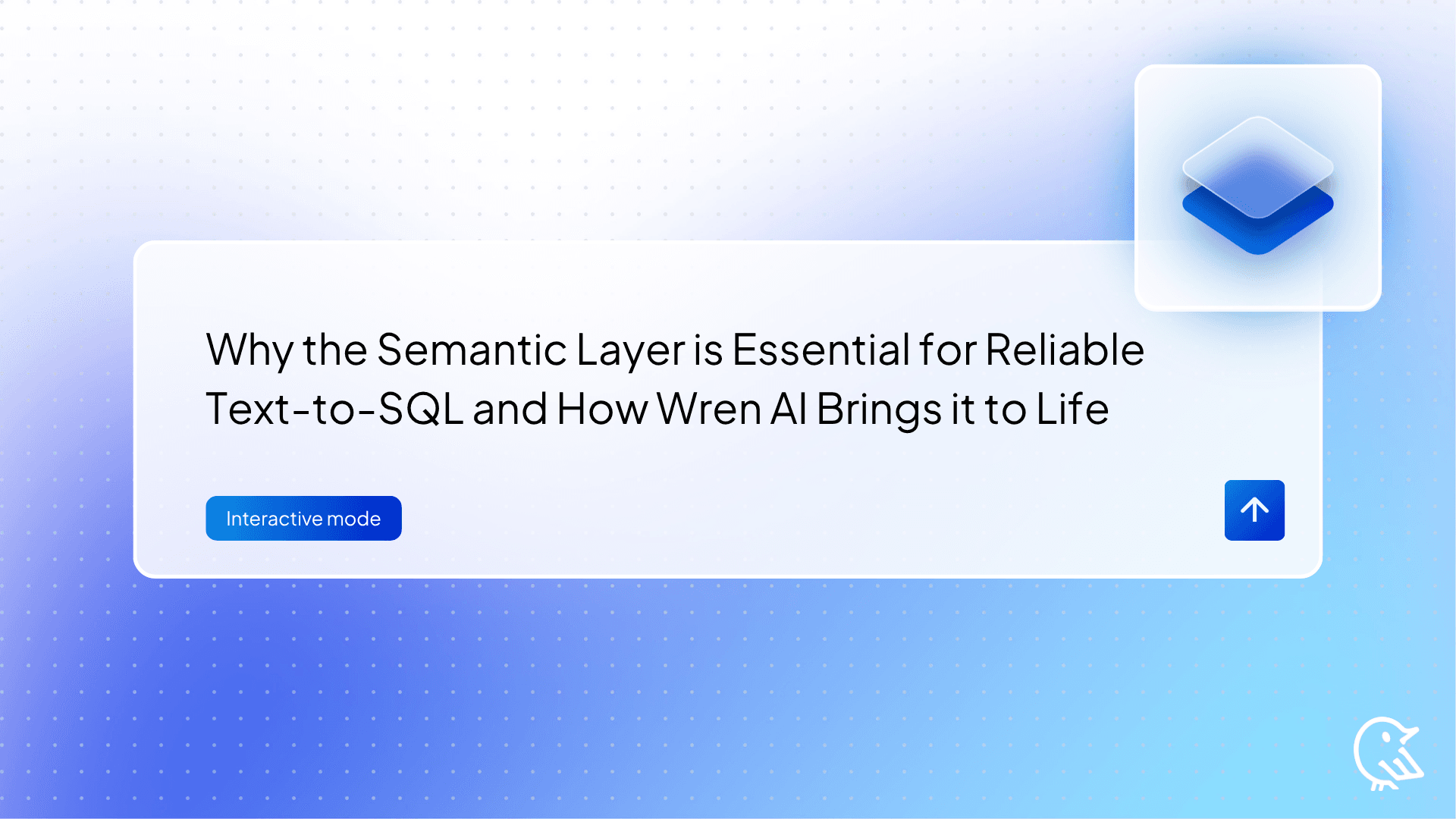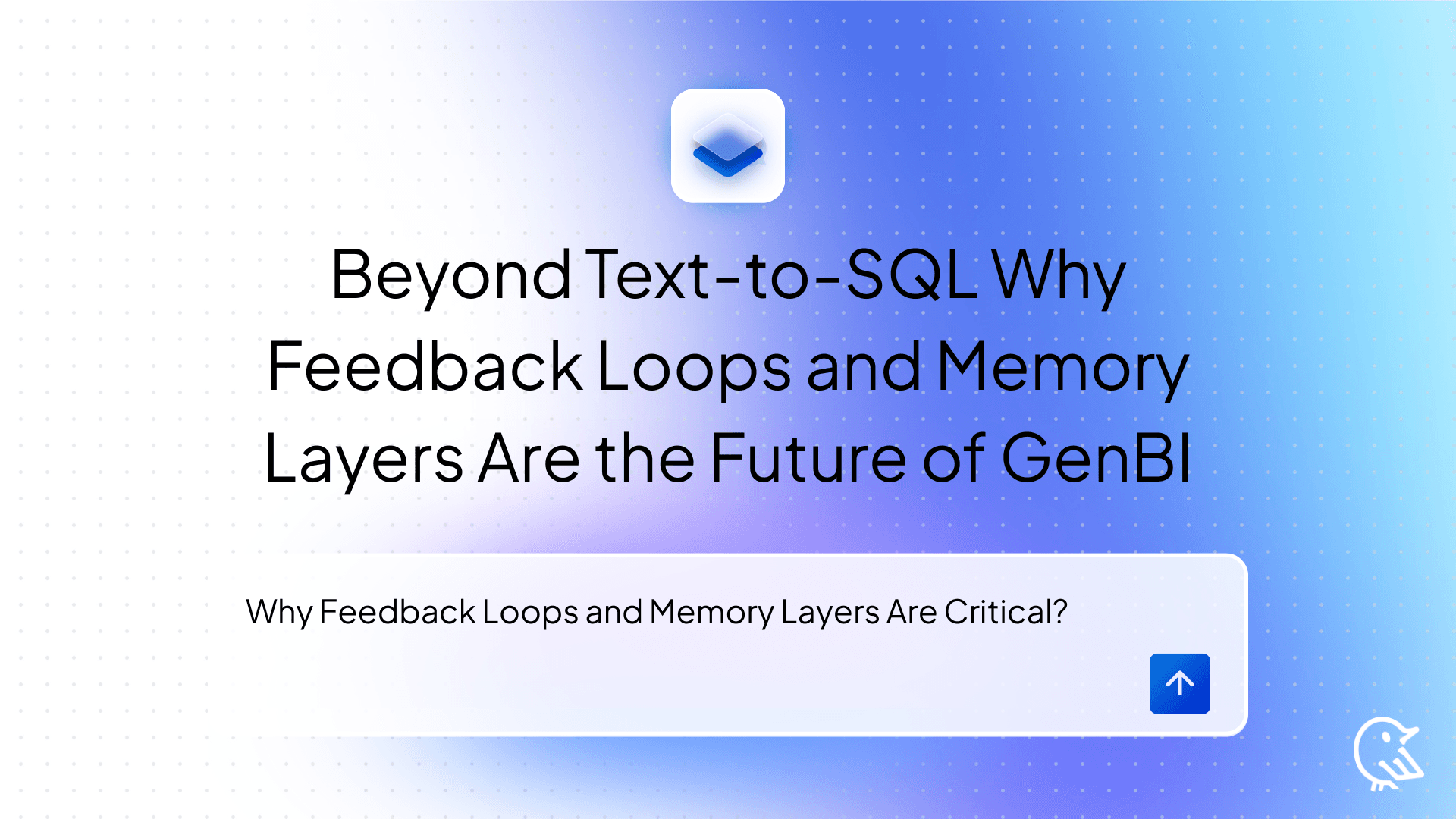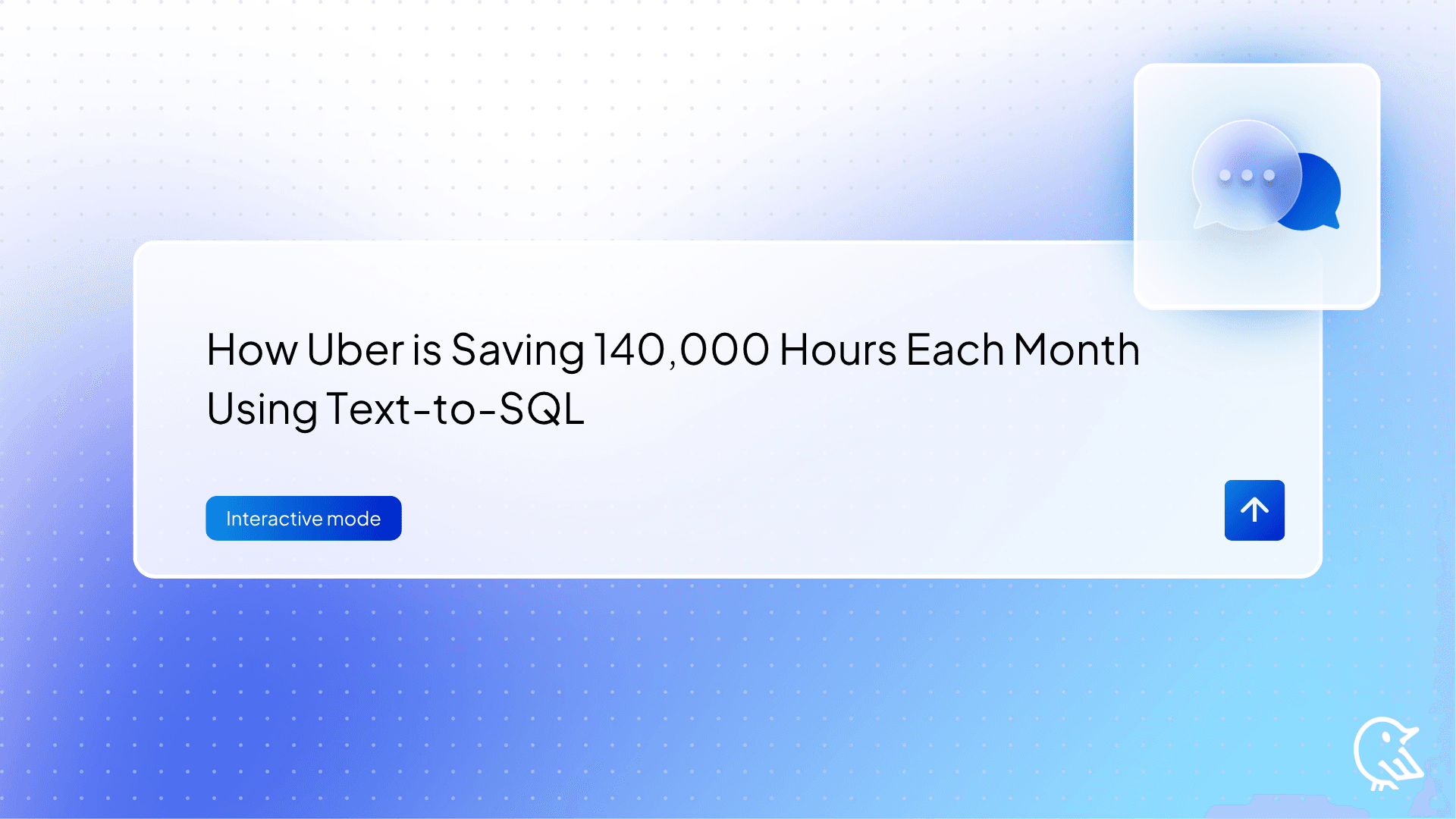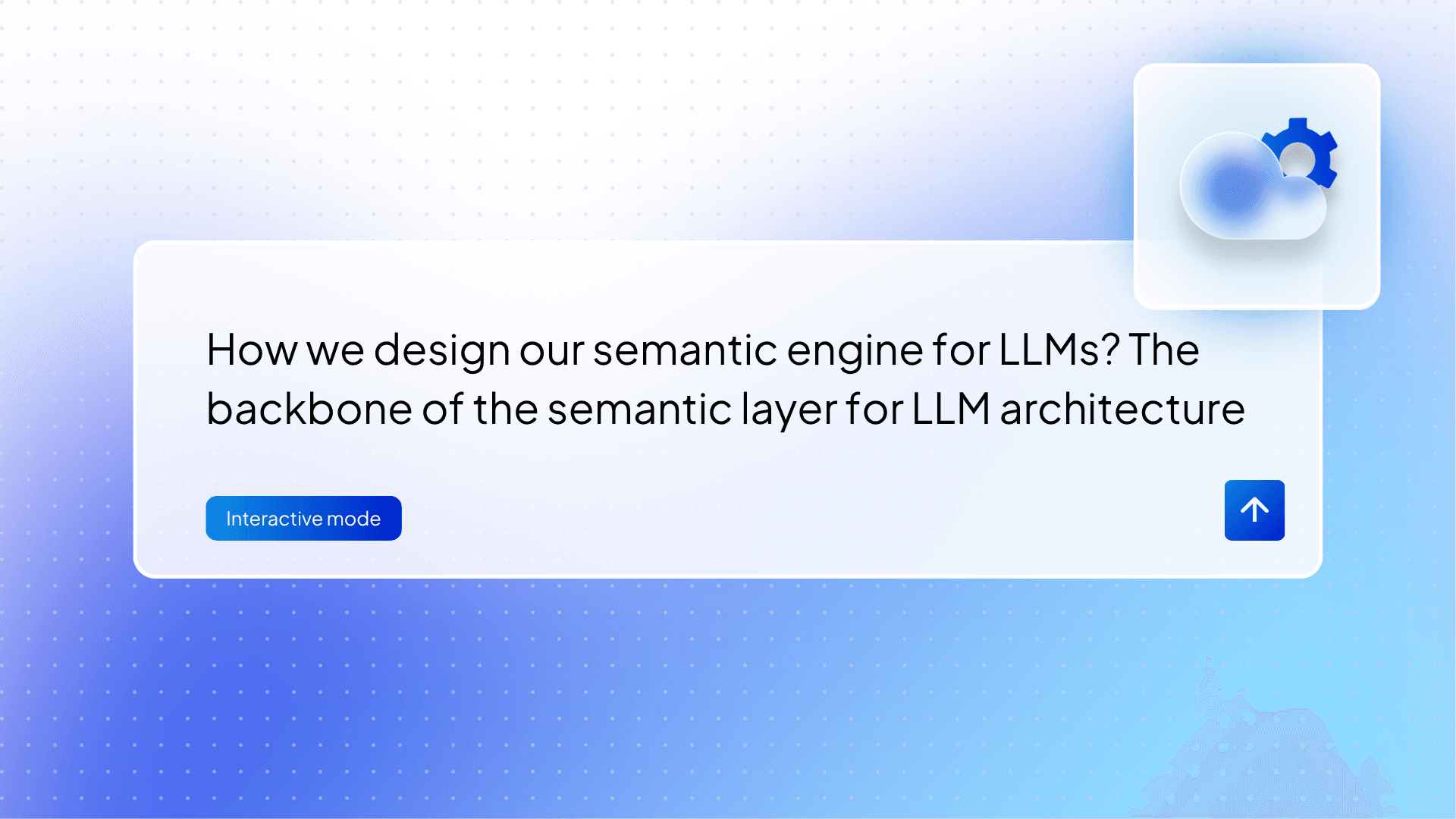Why the Semantic Layer is Essential for Reliable Text-to-SQL and How Wren AI Brings it to Life
Unlocking the Power of Natural Language Queries: How the Semantic Layer Transforms Text-to-SQL with Wren AI

Howard Chi
Updated: Oct 08, 2025
Published: Dec 10, 2024

In the world of data analytics, there’s a growing desire to empower anyone — not just developers or SQL-savvy analysts — to ask questions about data in plain language and get meaningful answers. The promise of “text-to-SQL” technology is to do just that: type in a question and watch as the system generates a working SQL query. However, this promise often hits a serious stumbling block. While large language models (LLMs) and text-to-SQL solutions have improved significantly in understanding natural language, they still struggle with a fundamental challenge: aligning user queries with the complex reality of enterprise data structures.
Many organizations rely on large, evolving data schemas. Tables expand, new data sources arrive, column names get changed, and business definitions of key metrics shift over time. Without a stable framework to interpret user intent, purely language-based approaches to text-to-SQL often yield incomplete, ambiguous, or incorrect queries — especially as data complexity grows.
The key to making text-to-SQL not just workable but reliable and scalable lies in the concept of the semantic layer. By introducing a semantic layer — a structured representation of business concepts, metrics, and relationships — organizations can dramatically improve both the accuracy and maintainability of their natural language interfaces to data.
Where Traditional Text-to-SQL Without Semantics Falls Short
A text-to-SQL system fundamentally tries to map two different worlds:
1. Human Language: Questions posed as free-form text — “What were our total sales last quarter in Europe?”
2. Database Schemas: Complex data structures consisting of tables, columns, joins, and transformations that aren’t always intuitive or stable over time.
Without a semantic layer, a text-to-SQL model relies primarily on pattern matching and inference. While LLMs are great at understanding linguistic patterns, they do not inherently know which table holds “sales” data, or that “Europe” corresponds to certain values in a geographic dimension table. Without clear definitions, the system can easily get lost:
Guesswork Instead of Understanding:
Without semantics, the model tries to guess how terms map to columns or tables. If your data structure is large or changes frequently, these guesses quickly lead to inconsistent or incorrect queries.
Fragility Under Change:
If a column name changes or a new table is introduced, a model without semantic support suddenly faces a new puzzle. It has no steady anchor. A previously well-functioning query might start to fail or return unexpected results, requiring constant prompt engineering or retraining.
No Shared Definitions of Metrics:
Without a semantic layer, every time you ask for “total sales” or “average order value,” the model has to infer what that means. Different queries might produce slightly different logic, leading to metric drift and a lack of confidence in the results.
Limited Domain Context:
Complex business concepts — like “churn,” “customer loyalty,” or “profit margin” — are not simply strings of text. They have specific, often evolving definitions that depend on multiple tables, filters, or derived calculations. Without encoding these definitions in some structured form, the model cannot consistently produce correct SQL.
Put simply, pure text-to-SQL solutions often end up producing brittle and opaque query generation. Analysts still spend time validating outputs, data engineers still field requests for clarification, and business stakeholders remain uncertain whether they can trust the answers.
Enter the Semantic Layer: Stability and Context for Text-to-SQL
The semantic layer offers a conceptual framework to overcome these challenges. Instead of asking the text-to-SQL system to figure out everything on-the-fly, you supply it with a consistent semantic definition of your data domain.
What is a Semantic Layer?
A semantic layer is a model that bridges the gap between the way humans speak about their business and how data is physically stored. In it, you define entities (like “customers” or “products”), metrics (like “total sales” or “conversion rates”), relationships between data tables, and standardized filters or attributes. The semantic layer essentially encodes business logic and data definitions in a structured form, creating a stable reference point for query generation.

Semantics behind a data structure
Here are some key Benefits:
Clarity and Consistency:
With a semantic layer, the meaning of “total sales” or “average order value” is defined once and reused. Every query that asks for these metrics taps into the same definition. This reduces discrepancies and confusion, ensuring that everyone is on the same page.
Robustness Amid Change:
When underlying tables or column names evolve, you only need to update the semantic layer’s definitions rather than retrain or heavily modify your text-to-SQL system. The logic that associates user-facing concepts with database structures remains intact, providing resilience against schema drift.
Domain Context Encoding:
The semantic layer can capture the nuances of domain-specific language. Instead of treating “customer lifetime value” as just another phrase, it recognizes it as a metric derived from specific tables, columns, and calculations. This domain context drastically improves query accuracy.
Reduced Cognitive Load for Users:
Users don’t need to understand the intricacies of the database schema. They can ask natural language questions using business terminology, knowing the semantic layer will faithfully translate that into accurate SQL.
The Role of a Semantic Engine in Building This Layer
Creating and maintaining a semantic layer is not trivial. It often involves describing entities, metrics, and relationships in a structured way. A robust semantic engine can help here by providing a means to define these relationships, store them, and serve them to the text-to-SQL system.

Image from the Wren Engine GitHub
Metadata Definition Language (MDL) is one way to define a semantic model. With MDL, you encode your domain knowledge once:
- Entities: Define high-level concepts (like “Customer” or “Order”) and map them to the underlying tables and columns.
- Metrics and Dimensions: Standardize metrics (such as “Total Sales,” “Average Order Value”) and the dimensions that slice them (time periods, regions, product categories).
- Filters and Transformations: Specify how to interpret filters like “last quarter” or “in Europe.”
- Evolving Over Time: As your business changes, you can update the semantic definitions instead of rewriting SQL or re-engineering prompts.
This formalized approach to semantics creates a stable environment for generating queries. Your text-to-SQL solution will reference these MDL definitions when interpreting user queries, ensuring that the SQL it produces reflects the correct relationships and logic.
Introducing Wren AI: A Semantics-Driven Text-to-SQL Approach
While the concept of the semantic layer is powerful, it’s often challenging to implement. This is where solutions like Wren AI come in. Wren AI is an open-source text-to-SQL solution that was designed from the ground up to integrate semantics into its core.

A Semantics-Driven modeling layer
Instead of treating semantics as an afterthought, Wren AI’s architecture puts the semantic layer front and center. It leverages a semantic engine (the Wren AI Engine) and MDL-based modeling to:
Tie Natural Language Queries to Well-Defined Semantics:
When a user asks a question, Wren AI consults its semantic layer to understand what the user’s words mean in the context of the business domain. This ensures the SQL it generates isn’t just grammatically correct — it’s logically aligned with the defined business concepts.
Reduce Guesswork and Maintain Stability:
Instead of relying on pattern recognition alone, Wren AI has a blueprint that tells it how data should be understood. Schema changes or additions are less disruptive because they’re absorbed into the semantic model rather than confusing the entire system.
Enable Domain-Specific Intelligence:
Many domains have unique concepts. With Wren AI’s semantic modeling, you can precisely define those concepts and ensure that queries referencing them always produce meaningful, accurate results.
What sets Wren AI apart from many text-to-SQL tools is that it’s not solely depending on an LLM to figure everything out. LLMs provide the language understanding capabilities, but the semantics are baked in through a well-defined layer that ensures consistent, accurate mapping to your data’s structure.
Comparing Traditional and Semantics-Driven Approaches

Traditional vs. Semantics approach
The difference here is not just technical — it’s strategic. By adopting a semantic layer, you’re setting your data environment on a more sustainable, scalable foundation. As new questions arise or data sources are added, you avoid constant firefighting and patchwork solutions.
Moving Towards a Future of Reliable Natural Language Queries
As natural language interfaces become standard in data analytics, the semantic layer emerges as the critical piece that turns promising prototypes into dependable, production-ready tools. It’s the difference between a system that mostly works when conditions are perfect, and one that consistently delivers accurate results in a dynamic, real-world environment.
For organizations looking to move beyond the status quo, integrating a semantic layer isn’t just a technical upgrade — it’s a way to future-proof their data strategy. Wren AI’s approach demonstrates this: by placing semantics at the heart of the text-to-SQL process, it creates a solution that is both more intuitive for end-users and more maintainable for data teams.
Conclusion: Embracing Semantics for Better Data Accessibility
In a data-rich world, the real challenge is making information accessible and understandable to everyone, regardless of technical skill. Text-to-SQL was conceived to solve this problem, but it can’t fulfill its potential without a stable semantic foundation. A semantic layer ensures that natural language queries are not mere guesswork; they become reliable gateways to actionable insights.
If you’re ready to see how a semantic-first text-to-SQL solution can transform your analytics experience, we invite you to explore Wren AI 🙌.
You can also dive into our open-source offering on Wren AI OSS on GitHub 😍and start building a more intuitive, future-proof data environment today.
Supercharge Your
Data with AI Today
Join thousands of data teams already using Wren AI to make data-driven decisions faster and more efficiently.
Start Free TrialRelated Posts
Related Posts

Beyond Text-to-SQL: Why Feedback Loops and Memory Layers Are the Future of GenBI
How Wren AI’s Innovative Approach to Question-SQL Pairs and Contextual Instructions Delivers 10x More Accurate Generative Business Intelligence

How Uber is Saving 140,000 Hours Each Month Using Text-to-SQL — And How You Can Harness the Same Power
Discover how Uber’s Text-to-SQL technology streamlines data queries and learn how to apply this efficiency to your operations.

How we design our semantic engine for LLMs? The backbone of the semantic layer for LLM architecture.
The advent of Trend AI agents has revolutionized the landscape of business intelligence and data management. In the near future, multiple…

